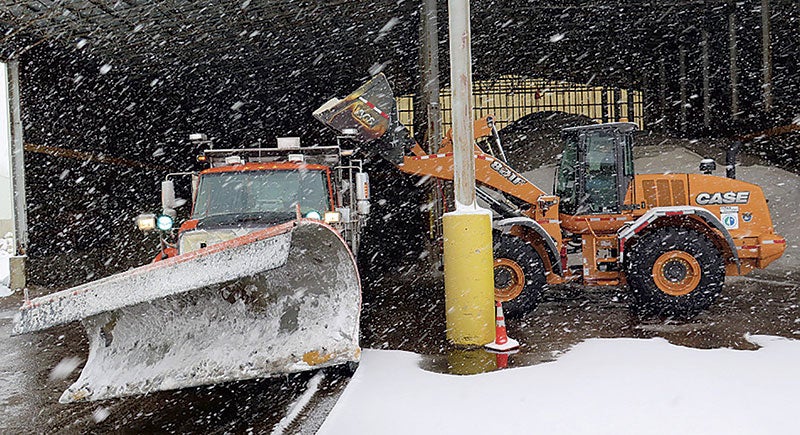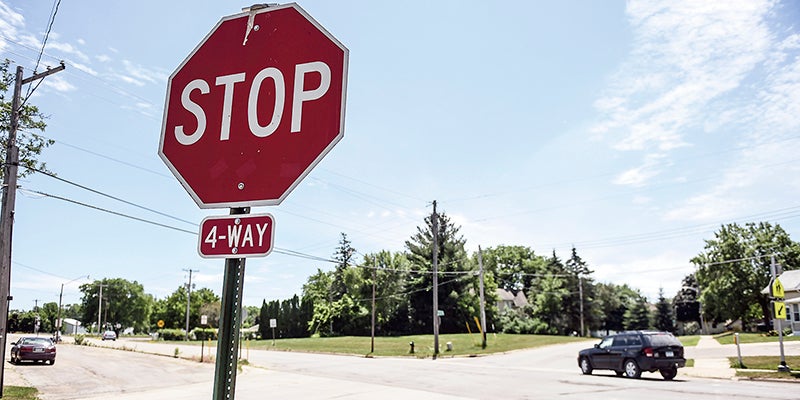MnDOT cuts back road salt use to save money, protect water
Published 10:15 am Monday, April 3, 2017

- A loader fills a plow with salt at MnDOT’s truck station in St. Paul last year. Elizabeth Dunba/MPR News file photo
By Kirsti Marohn
MPR.org/90.1 FM
ST. CLOUD — Winter is over, but a towering mountain of road salt still sits in a vast storage shed at the Minnesota Department of Transportation’s district headquarters here.
Part of the salty surplus is due to this year’s unusual weather. But there’s another reason: Over the last few years, MnDOT has been cutting back on using salt to melt ice on the state’s highways.
“We’re always looking for ways to reduce the amount of salt, save money and protect the traveling public,” said Jamie Hukriede, district maintenance engineer.
The effort is aimed at saving not only money, but the environment. The chloride in road salt is causing serious and permanent pollution in Minnesota lakes, rivers and streams.
“We’ve had a bit of a slow-motion disaster unfolding with road salt since it became popular in the 1950s,” said Steve Woods, executive director of the Freshwater Society. “The underlying problem is once salt gets into the water, it stays in the water. There isn’t any bacteria or any other biological process that removes it from the water.”
Many other pollutants eventually break down, get used up by other organisms or converted into something less toxic, Woods said. That’s not the case with chloride.
“It will remain chloride essentially forever, and it will stay with that water wherever that water flows,” he said.
All that excess salt is accumulating in lakes, rivers, streams and wetlands. Nearly 40 water bodies in the Twin Cities already have more chloride than water quality standards allow, said Trevor Russell, water program director for Friends of the Mississippi River. Another 40 or so will soon become impaired, meaning they don’t fully support aquatic life due to high salt levels.
Russell said the Mississippi is seeing increased salt levels from polluted tributaries that flow into it.
“As the river moves through the Twin Cities, it picks up quite a lot of chloride,” he said. “In fact, since 1985 we’ve seen about an 81 percent increase in chloride concentrations in the metro Mississippi River.”
Those concentrations are still fairly diluted, so scientists haven’t yet detected impacts on aquatic life from chloride in the Mississippi, Russell said. But that’s not the case with some of its tributaries, which have much higher concentrations.
The problem with chloride is that it’s toxic to the fish, plants and insects living in those waters. It doesn’t take much salt — about 230 milligrams per liter, or the equivalent of about 1 teaspoon in a five-gallon bucket of water — to start to see negative impacts on aquatic life.
High chloride levels also have turned up in ground water samples collected across the state. So far, it’s only been at shallow levels. But there’s concern that the chloride could travel to deep aquifers where the majority of Minnesotans get their drinking water. Low levels of salt don’t pose a health concern for humans, but they can make the water taste funny, and removing salt is very expensive.
Why don’t road agencies use something other than salt to melt the ice on the roads? Other products have been tried, including cheese brine, beet juice and corn syrup. Some have side effects, like leaving behind an unpleasant odor or a residue on the road and vehicles. Also, alternative products often pose their own environmental problems, said Brooke Asleson, a watershed specialist with the Minnesota Pollution Control Agency.
“Unfortunately, there’s just not any kind of silver bullet out there waiting for us to just switch over,” Asleson said.
Instead, state and local road engineers have been working to use road salt as effectively as possible so they don’t have to use as much.
About a year ago, the MPCA worked with local communities and watershed organizations to create a chloride management plan for the seven-county Twin Cities metro area. It includes best practices for plow drivers and private contractors hired to clear parking lots and sidewalks.
Now state officials hope to expand that effort statewide, Asleson said.
“If we can get out to those communities early, ahead of time, and get those practices improved and prevent these conditions from occurring, then everybody will be better off,” she said. “It’s always more cost effective to prevent pollution than it is to try to deal with it after the fact.”
Asleson said many cities that have seen significant budget savings from using less salt.
“When you make these changes, you’re not only protecting the environment, you also are saving yourself money,” she said.
At MnDOT, snowplow drivers have access to some high-tech equipment to help them apply just the right amount of salt at the right time. Inside the plow’s cab, there’s a GPS screen that gives the driver the outside air temperature, wind speed and even the temperature of the pavement. It’s much different than the snowplows of 20 years ago, said Mike Kiley, roadway maintenance supervisor.
“Our controls are all operated by computers now,” Kiley said. “We have little joysticks to operate plows, wings, other blades. It’s very, very technical. We don’t necessarily service roads faster or better. I think we do it more efficiently, and we definitely use less chemicals.”
Recently, MnDOT added chutes to its trucks so the salt slides onto the road right where the drivers want it and is less likely to bounce off into the ditch.




